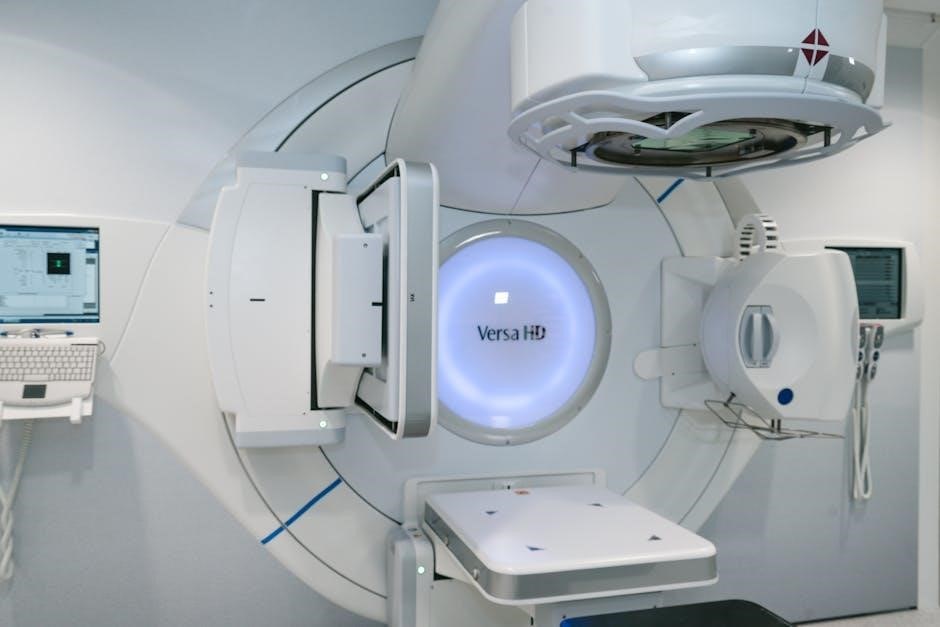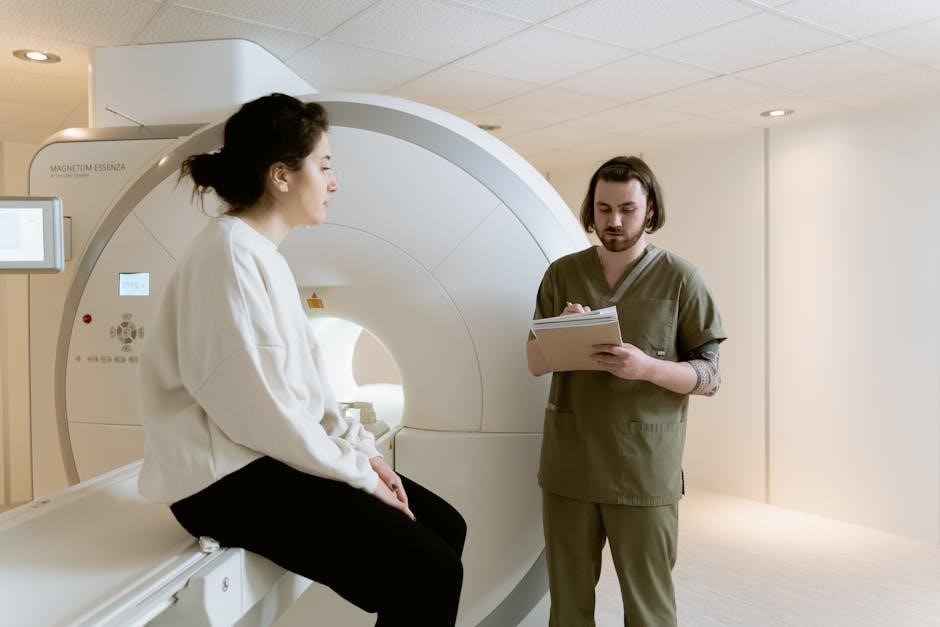
Image-Guided Superficial Radiation Therapy (IGSRT) is a non-invasive, FDA-cleared treatment using low-energy X-rays and advanced imaging to target skin cancers like basal and squamous cell carcinoma effectively.
Definition and Purpose of IGSRT
Image-Guided Superficial Radiation Therapy (IGSRT) is a non-invasive cancer treatment utilizing low-energy X-rays and advanced imaging to precisely target skin cancer cells. Its primary purpose is to treat non-melanoma skin cancers, such as basal and squamous cell carcinomas, without surgery. By combining high-resolution imaging with controlled radiation, IGSRT ensures accurate delivery, minimizing damage to healthy tissue while offering high cure rates and excellent cosmetic outcomes.
Historical Development and FDA Clearance
Image-Guided Superficial Radiation Therapy (IGSRT) evolved from traditional Superficial Radiation Therapy (SRT), with advancements in imaging technology. The FDA cleared IGSRT in 2015, integrating high-resolution dermal ultrasound for enhanced precision. This innovation marked a significant leap in treating non-melanoma skin cancers, offering a non-invasive alternative with improved outcomes. The development of devices like the SRT-100 Vision further solidified IGSRT’s role in modern dermatologic oncology, enabling precise, image-guided treatments.

How Image-Guided Superficial Radiation Therapy Works
IGSRT uses advanced imaging techniques like high-resolution dermal ultrasound to guide low-energy X-rays, precisely targeting cancer cells while minimizing exposure to healthy tissue.

The Role of Imaging Techniques in IGSRT
Imaging techniques in IGSRT, such as high-resolution dermal ultrasound, provide precise visualization of tumors, enabling accurate targeting of cancer cells. This ensures low-energy X-rays are delivered directly to the affected area, sparing healthy tissue. Advanced imaging guides treatment planning and real-time adjustments, enhancing accuracy and efficacy. These technologies are integral to IGSRT’s success, offering a non-invasive and effective treatment option for skin cancer patients.
Targeting Cancer Cells with Low-Energy X-Ray Radiation
IGSRT utilizes low-energy X-ray radiation to precisely target cancer cells, minimizing damage to surrounding healthy tissue. The technology delivers controlled doses of radiation, ensuring effective treatment while preserving skin integrity.
This approach is particularly advantageous for superficial lesions, as the low-energy X-rays penetrate only a short distance, focusing treatment on the tumor site. The precision of IGSRT enhances outcomes for patients with non-melanoma skin cancers, offering a safe and efficient therapy option.

Benefits of IGSRT for Skin Cancer Treatment
IGSRT offers a non-invasive, surgery-free alternative with high cure rates, minimal scarring, and excellent cosmetic outcomes, making it ideal for treating non-melanoma skin cancers effectively.

Non-Invasive and Surgery-Free Alternative
IGSRT is a non-invasive, surgery-free method that eliminates cancer cells using low-energy X-rays. FDA-cleared, it’s ideal for treating basal and squamous cell carcinomas, especially in sensitive or hard-to-reach areas. By avoiding surgery, it minimizes scarring and preserves skin appearance. The SRT-100 Vision device, combined with high-resolution dermal ultrasound, ensures precise targeting. This approach offers minimal side effects and high patient satisfaction, making it a preferred alternative for patients seeking to avoid surgical procedures.
High Cure Rates and Cosmetic Outcomes
IGSRT achieves high cure rates, with a 99% success rate for basal and squamous cell carcinomas. It ensures excellent cosmetic outcomes by minimizing scarring and preserving skin appearance. Patients experience healthy tissue regrowth post-treatment. Studies show low recurrence rates and high satisfaction, making it a preferred option for non-melanoma skin cancers.

Technology and Devices Used in IGSRT
IGSRT utilizes advanced devices like the SRT-100 Vision, combining low-energy X-rays with high-resolution dermal ultrasound for precise, non-invasive skin cancer treatment.
The SRT-100 Vision Device and Its Features
The SRT-100 Vision, developed by Sensus Healthcare, integrates high-resolution dermal ultrasound with superficial radiation therapy, enabling precise targeting of skin cancers. It delivers low-energy X-rays to treat non-melanoma skin cancers, such as basal and squamous cell carcinomas, with minimal exposure to healthy tissue. This device offers a non-invasive alternative to surgery, ensuring high cure rates and excellent cosmetic outcomes.
Integration of High-Resolution Dermal Ultrasound
High-resolution dermal ultrasound is seamlessly integrated into IGSRT, offering precise tumor visualization. This imaging modality enhances treatment accuracy, allowing clinicians to deliver radiation doses effectively while minimizing exposure to surrounding healthy tissue. The ultrasound provides real-time guidance, ensuring optimal targeting and improving patient outcomes in non-melanoma skin cancer treatments, particularly for basal and squamous cell carcinomas.
Clinical Applications of IGSRT
IGSRT is primarily used to treat non-melanoma skin cancers, including basal and squamous cell carcinomas, offering a non-invasive solution for sensitive or hard-to-treat areas effectively.
Treatment of Non-Melanoma Skin Cancers
IGSRT is a highly effective treatment for non-melanoma skin cancers, including basal and squamous cell carcinomas. It uses low-energy X-rays guided by imaging to precisely target cancer cells, minimizing damage to surrounding healthy tissue. With high cure rates and minimal side effects, IGSRT is particularly advantageous for tumors in sensitive or hard-to-treat locations. The integration of high-resolution dermal ultrasound enhances tumor visualization, ensuring accurate and localized treatment delivery.
Efficacy in Basal Cell and Squamous Cell Carcinomas

IGSRT demonstrates exceptional efficacy in treating basal and squamous cell carcinomas, achieving high cure rates and low recurrence. The precise delivery of low-energy X-rays, guided by advanced imaging, ensures effective tumor control while preserving surrounding tissue. Clinical studies show a 99% cure rate for basal cell carcinoma and similarly high outcomes for squamous cell carcinoma. This non-invasive approach is particularly beneficial for tumors in sensitive or difficult-to-treat areas, offering excellent cosmetic and functional results.
Safety and Precision in IGSRT
IGSRT ensures precise targeting of cancer cells while minimizing radiation exposure to healthy tissue, enhancing safety and treatment accuracy with advanced imaging guidance.
Minimizing Radiation Exposure to Healthy Tissue

IGSRT employs advanced imaging to precisely target cancer cells, ensuring minimal radiation exposure to surrounding healthy tissue. High-resolution dermal ultrasound and low-energy X-rays confine treatment to superficial layers, reducing side effects and promoting faster healing. This focused approach minimizes damage to adjacent structures, offering a safer alternative to traditional radiation therapy while maintaining high efficacy in treating non-melanoma skin cancers.
Comparison with Traditional Radiation Therapy
IGSRT differs from traditional radiation therapy by using low-energy X-rays and advanced imaging to target superficial skin cancers precisely. Unlike conventional methods, IGSRT minimizes radiation exposure to healthy tissue, reducing side effects. Its non-invasive approach eliminates the need for surgery, offering superior cosmetic outcomes. IGSRT’s focused delivery ensures higher efficacy for non-melanoma skin cancers, making it a safer and more modern alternative to traditional radiation techniques.
Clinical Evidence and Outcomes
Studies demonstrate IGSRT’s high cure rates, with a 99% success rate for basal and squamous cell carcinomas, and low recurrence rates, ensuring effective skin cancer management.
Studies Demonstrating IGSRT’s Effectiveness
Recent studies highlight IGSRT’s exceptional outcomes, with a 99% cure rate for basal and squamous cell carcinomas. McClure et al. (2023) found IGSRT significantly outperformed Mohs surgery, reducing recurrence rates. Clinical trials also show high patient satisfaction and minimal side effects, solidifying IGSRT as a highly effective treatment for non-melanoma skin cancers, with low complication rates and superior cosmetic results compared to traditional methods.
Recurrence Rates and Patient Satisfaction

IGSRT demonstrates exceptional results with a 99% cure rate for basal and squamous cell carcinomas. Studies show significantly lower recurrence rates compared to traditional methods, with high patient satisfaction due to its non-invasive nature. Patients appreciate the minimal side effects, rapid treatment sessions, and excellent cosmetic outcomes, making IGSRT a preferred choice for skin cancer treatment with lasting results and improved quality of life.

Future Directions and Advancements
Emerging trends include integrating IGSRT with other therapies, enhancing imaging precision, and improving dose delivery systems for better outcomes and reduced side effects.
Emerging Trends in Image-Guided Radiation Therapy
Emerging trends in IGSRT include advancements in high-resolution dermal ultrasound, adaptive radiation protocols, and integration with real-time imaging technologies. These innovations aim to enhance precision, reduce side effects, and improve cosmetic outcomes. Additionally, combining IGSRT with other therapies, such as immunotherapy, is being explored to optimize treatment efficacy for non-melanoma skin cancers. Such advancements are expected to expand its application and improve patient care.
Potential Integration with Other Cancer Treatments
IGSRT’s precision and non-invasive nature make it a promising candidate for integration with other therapies, such as immunotherapy or chemotherapy. This combination could enhance treatment efficacy, particularly for complex or advanced skin cancers. Research explores how IGSRT’s localized radiation might complement systemic treatments, potentially improving outcomes for patients with multiple or recurring tumors. Such integration aims to maximize therapeutic benefits while minimizing side effects, offering a comprehensive approach to cancer care.
IGSRT emerges as a groundbreaking, non-invasive treatment for skin cancer, offering high cure rates and excellent cosmetic outcomes, making it a transformative option in modern oncology.
IGSRT as a Promising Treatment Option
IGSRT stands out as a promising treatment for non-melanoma skin cancers, offering a surgery-free alternative with minimal side effects. Its integration of high-resolution imaging ensures precise targeting, leading to high cure rates and superior cosmetic results. Patients benefit from shortened treatment sessions and reduced recovery time, making it an appealing choice for those seeking effective, non-invasive care.
Impact on Skin Cancer Management
IGSRT has revolutionized skin cancer management by offering a non-invasive, highly effective treatment with minimal complications. Its precision and high cure rates have made it a preferred option for basal and squamous cell carcinomas, reducing the need for surgery. By promoting faster healing and excellent cosmetic outcomes, IGSRT is redefining standards in dermatologic oncology, providing patients with a safer and more comfortable alternative to traditional methods.